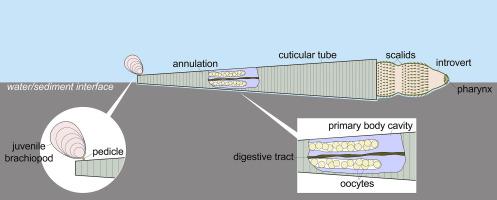Geoscience Frontiers ( IF 8.5 ) Pub Date : 2021-05-21 , DOI: 10.1016/j.gsf.2021.101234 Xiao-yu Yang , Jean Vannier , Jie Yang , Deng Wang , Xi-guang Zhang

|
In the recent years, exceptional fossil sites have revealed astonishing details on the anatomy, lifestyles and behaviour of Cambrian animals but surprisingly, very little is known about one of their most vital features, reproduction. We describe here in situ eggs (clusters of 3 to 30 oocytes) in the tube-dwelling priapulid worm Paraselkirkia sinica from the Cambrian Stage 3 Xiaoshiba Lagerstätte (ca. 514 Ma, South China). These oocytes were accommodated within paired tubular ovaries located in the posterior half of the primary body cavity as in modern meiobenthic priapulid worms, thus indicating that the general organization of female tubular gonads in priapulid worms has remained virtually unchanged for half a billion years. Our findings provide for the first time, key information on the reproductive organs and strategies of early ecdysozoans, a huge animal clade that dominated Cambrian marine ecosystems and accounts for a large part of today's biodiversity (e.g. arthropods). Moreover, we also emphasize the critical role of ecology on the reproductive strategies and lifestyles of both modern and Cambrian worms.











































 京公网安备 11010802027423号
京公网安备 11010802027423号